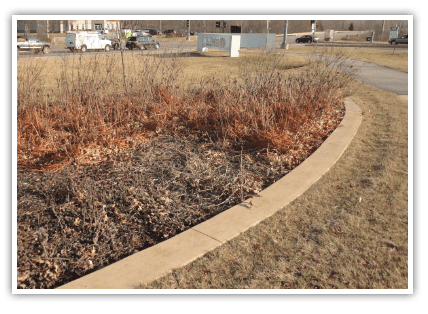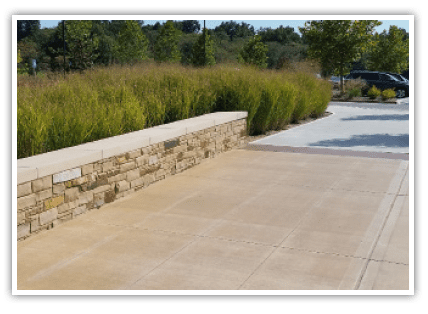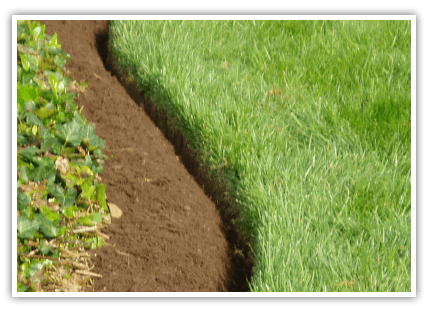Bed edges define planting areas and separate planting from adjacent turf, native areas or other features.
However, bed edge treatments can greatly increase the overall landscape maintenance required, and must be thought of differently in the context of the greenway system. Beds that are integrated into a surrounding paving area have the highest likelihood of being maintained to a high standard. Planting at trail nodes and other features can be worked into the layout of hardscapes and vertical elements, eliminating the need for bed-edging altogether.
RECOMMENDED USE:
- Edging should be designed with an eye on permanence. The best bed edging is surrounding pavement areas. Higher maintenance planting, of the sort that requires defined bed edges, is best installed at or near trail amenities and features. Beds can often be designed into a given space.
- Vertical, metal edge restraints should be avoided as they are often damaged by mowing.
- Paver edging, should similarly be avoided.
 CONCRETE HEADER – PREFERRED EDGE RESTRAINT
CONCRETE HEADER – PREFERRED EDGE RESTRAINT
A 6” to 12” wide concrete header, placed flush with the surrounding turf or native area, serves as a well-defined edge to a planting bed. Furthermore, flush headers are easily integrated into a regular mowing regime. Though headers are clearly more expensive than spade cut edges, concrete curbing machines can be used to greatly reduce the cost from traditional formwork.
BEST USE AREAS:
- Anywhere a well-defined bed is required within surrounding turf or natural areas. They are particularly well suited for areas that will be mowed very frequently.
PROS:
- Easy to mow around. Well-defined, permanent edge.
CONS:
- More expensive than traditional bed edging.
 SEATWALL / RAISED PLANTER
SEATWALL / RAISED PLANTER
To really define a planting area while also creating a more significant site feature, raised planters (typically at a height of 1-6” to 2’-6” to allow for seating) can be utilized. Raised planters should be large enough that they will not require significant water input, like large decorative pots. Planters should have a soils surface of at least 5’-0” wide by 5’-0” long. Lower planters, with a 6” to 1’-0” curb can also be used, where definition is desired, but should still be at least 5’-0” by 5’-0”.
BEST USE AREAS:
- Areas of high-visibility and high traffic. Areas where seating is desired.
PROS:
- Well-defined, permanent edge.
CONS:
- Very high overall cost, but is best integrated into a significant trail node. Must have large enough size to avoid high water requirements.
 SPADE CUT EDGE
SPADE CUT EDGE
Spade cut edges are fairly typical solutions for defining bed edges. A well-maintained spade cut edge can define a planting area with limited initial investment.
BEST USE AREA:
- Areas of high-visibility where high maintenance standard can be sustained, and where initial installation cost is a concern.
PROS:
- Very low-cost. Can be performed by landscape contractor.
CONS:
- Requires frequent maintenance. Can be a problem for mowing, when edges are over-excavated.
